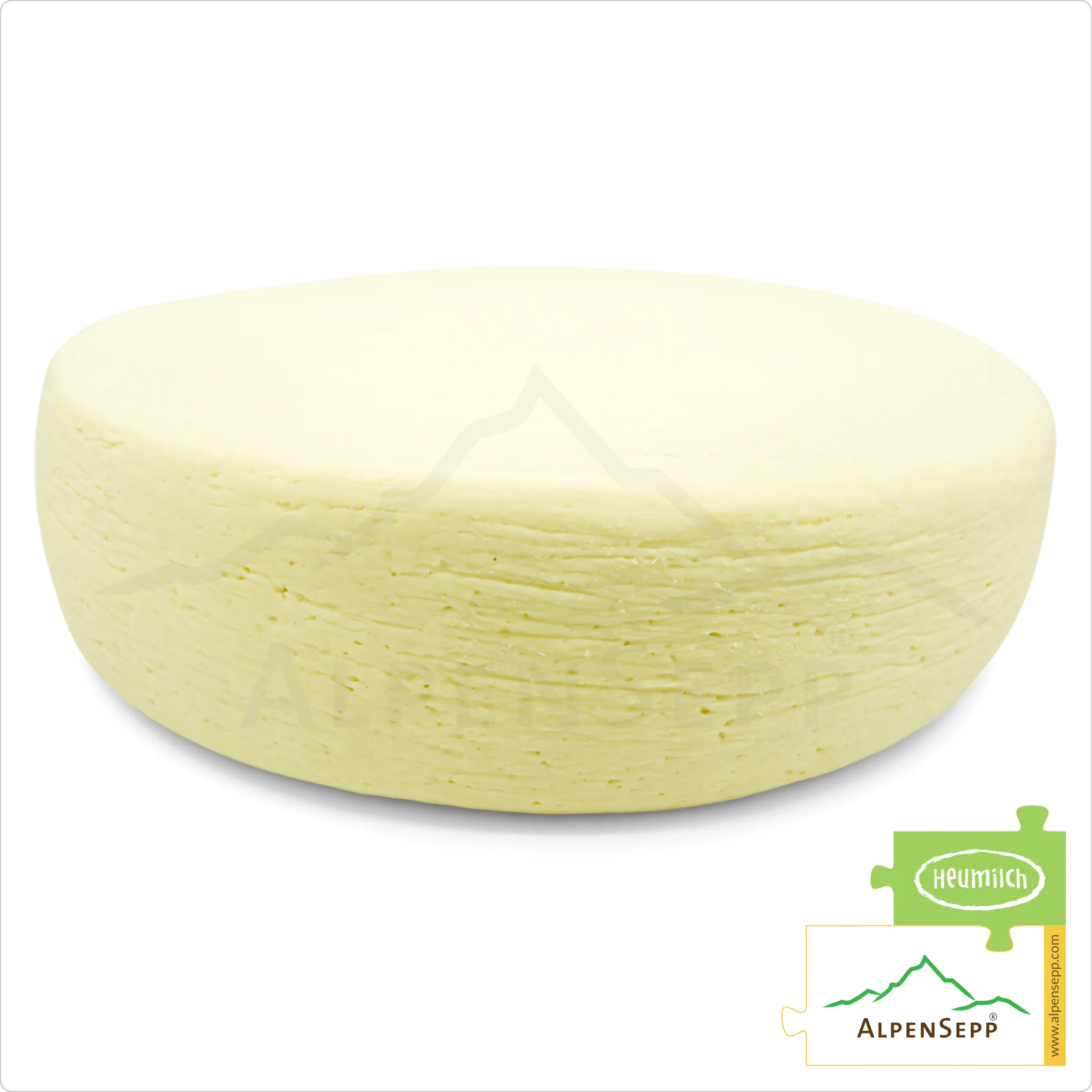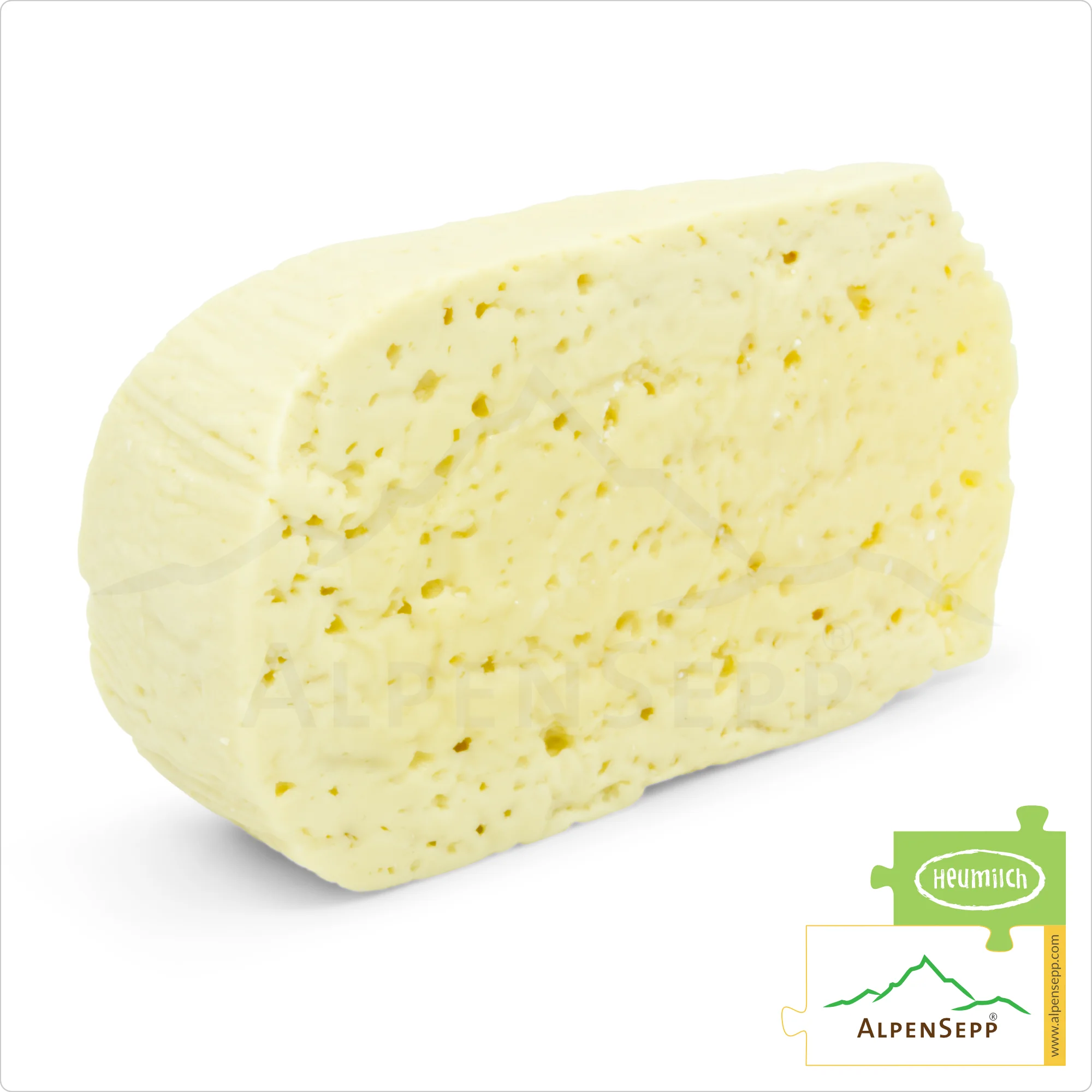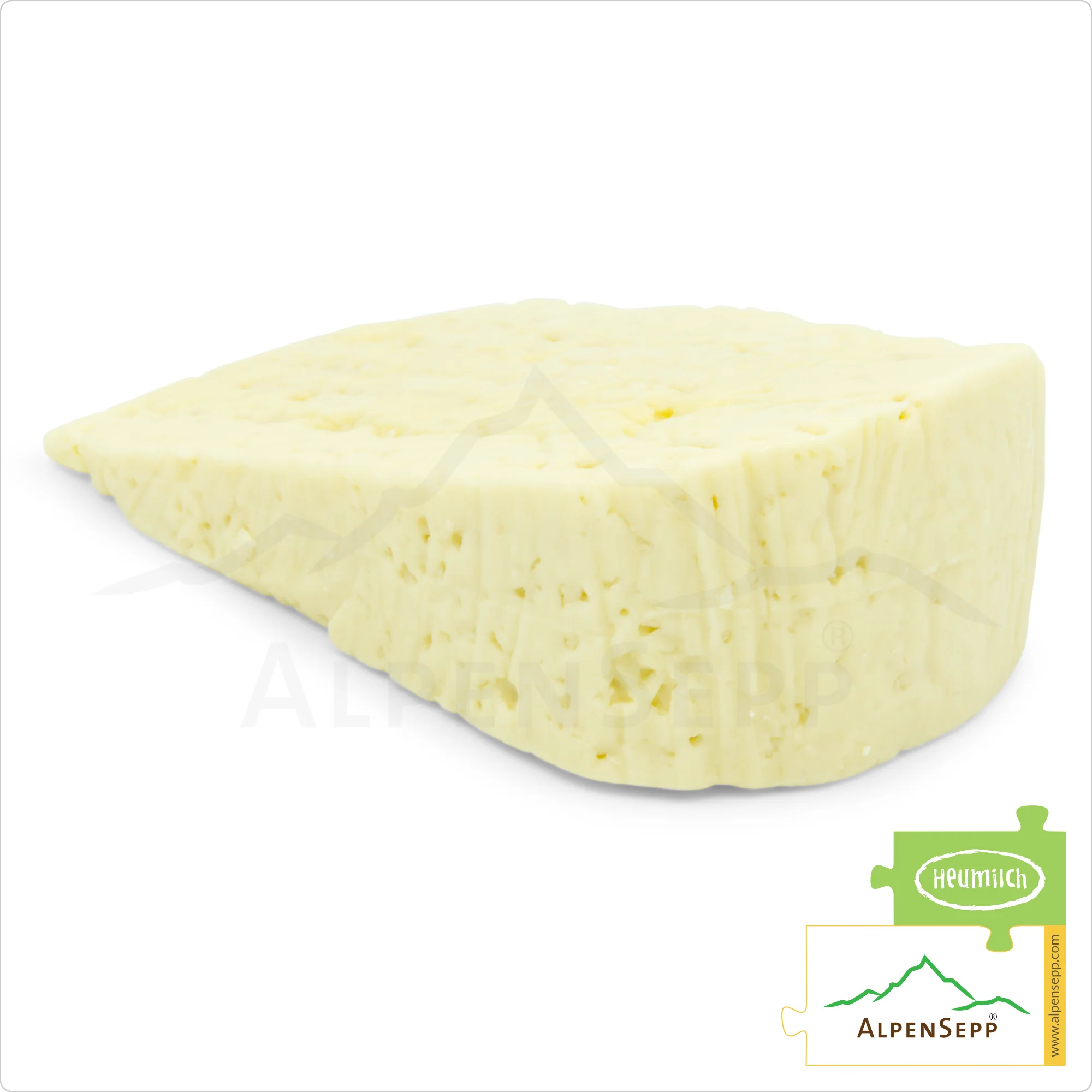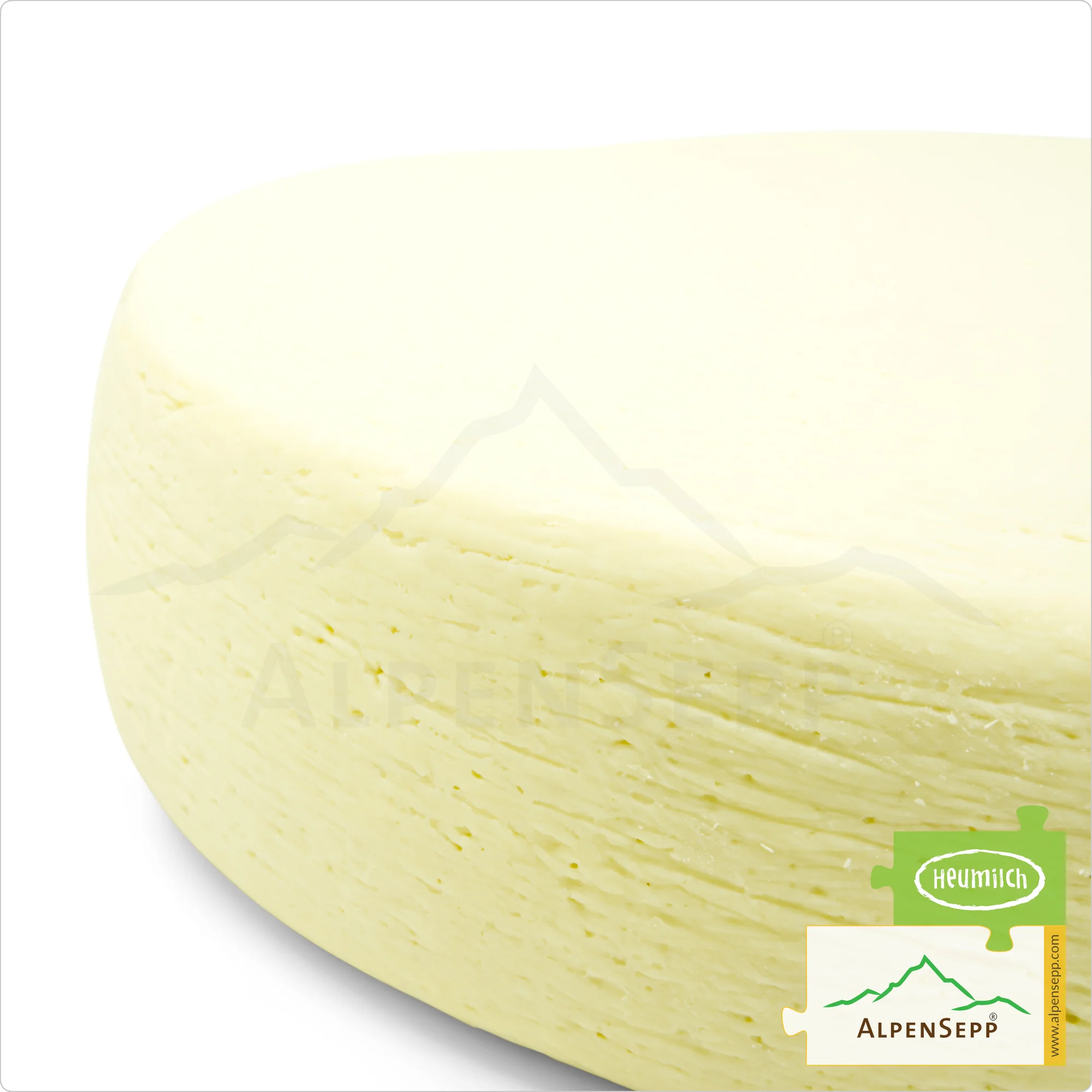Hard cheese | Mountain cheese
Semi-hard cheese

Original price was: € 192,06.€ 172,85Current price is: € 172,85. (incl. VAT)
Cheese Wheel SMELLY SPICY CHEESE Wet-Ripened, 6 kg
Base price: € 32,01/kg
The Vorarlberg expression “räss” means: spicy, sharp, intense in flavor. A hearty taste for the cheese lover.
Discover a completely new cheese creation by the master cheesemaker.
The wet matured smelly spicy cheese wheel is a naturally matured semi-hard cheese made from thermized cow’s milkCheese milk is the milk intended for the production of cheese, also with the concomitant use of buttermilk products, cream products, sweet whey, sour whey and whey cream (whey cream) » More info with extreme spiciness and intense cheese aroma. You could almost say: “If it’s too strong for you, you’re too weak.”
Wet maturation of the cheese wheel: After the salt bath, the cheese master wraps it in foil and stores it in the cheese ripeningAerobic cheese ripening means cheese ripening with oxygen. » More info cellarThe alpine cheese is best located in a cellar with high humidity. » More info at about 14°C. This creates a unique and very intense flavor experience.
Lactose-free Smelly Spicy Cheese: The naturalHere in Austria, we call our fresh, natural milk for our cheese production hay milk (hay mild standard) - in Germany it is different. » More info milk sugar in our cheese from hay milkHay milk comes from cows that are fed exclusively with fresh grassland feed, hay and little grain. » More info is broken down by lactic acid bacteriaBacterium Linens (red culture bacteria) are brushed with salt water on the cheese. » More info. Result: lactic acid plus extraordinary taste and aroma development.
The semi-hard cheese is also lactose-free, making it accessible to people with lactose intolerancePeople with lactose intolerance can not or only insufficiently digest milk sugar (lactose or lactose). » More info without compromising on flavor.
The production of wet matured smelly spicy cheese follows a special method: The edible outer skin of the wheel is treated with red smearRed smear is a surface threatment method used during cheese making and maturing. » More info bacteria and refined through a special salt treatment.
It then matures at higher temperatures and under airtight conditions. This treatment gives the cheese wheel a rindless surface plus a very intense cheese flavor paired with an extremely strong aroma.

The rindTo protect the cheese wheel, it is put into salt bath or turned into dry salt. The salt removes water from the cheese and it dries faster. So the rind is formed. » More info is a white smear rind with slight openings, and the cheese has a speck-like consistency when moist. The flavor is described as tangy and spicy.
Wet matured smelly spicy cheese is used in dishes due to its intense spiciness. In cheese production, it hardly differs from the dry matured smelly spicy cheese.
Our wet matured smelly spicy cheese belongs to the family of our spicy cheese varieties in our shop overview.
The cheese is spicy and robust in flavor, becoming tangy to slightly sharp with age. The uniformly distributed openings and reduced fat contentThe F.D.M. value related to dry matter, also depending on the water content of the cheese. The higher the water content (the more watery the cheese) the less dry matter and the less fat the cheese contains. » More info are special features of this cheese specialty.
The characteristic properties of Bregenzerwald smelly spicy cheese are greatly influenced by the high-quality AlpineThe Vorarlberger Bergkäse (mountain cheese) is a regional cheese specialty from the Austrian province Vorarlberg. » More info milk, its components and flavor/consistency, and the Vorarlberg Alpine flora. This results in the special qualityDetecting cheese defects and quality - on the cheese dough. Recognizing cheese defects requires some practice. » More info of Alpine cheese.
Find more fascinating details about smelly spicy cheese on Wikipedia.

Typical dishes with smelly spicy cheese include Vorarlberg cheese spaetzle or cheese flatbread.
No original Vorarlberg cheese spaetzle dish is complete without it – that’s the secret. For many lovers of spicy cheese, it’s also perfect on a cheese platter for solo enjoyment.
Smelly Spicy Cheese has a long-standing tradition as a specialty in Vorarlberg, indispensable in any cheese spaetzle mix. For a hearty “Brettljause” with a shot of enzian schnapps, the smelly spicy cheese is a delight.

Smelly spicy cheese features uniformly distributed openings.

Typical rind formation through treatment with saltwater. Due to wet cheese storage in foil, the rind is very moist.

The smelly spicy cheese is matured for about 4 months in foil in a cheese cellar. The result is cheese true to its name: exceptionally spicy and robust in flavor.
The specialty of this wet matured smelly spicy cheese wheel is its extreme aroma and flavor.
Smelly Spicy Cheese, wet matured Intensity
How mild or spicy is the cheese? We define 10 levels from 0 (mild) to 10 (spicy).
Smelly Spicy Cheese, wet matured Consistency
How hard is the cheese? We define 10 levels from 0 (soft) to 10 (hard).
Smelly Spicy Cheese, wet matured Ripening Time
How long did the cheese mature? We define ripening time between 1 and 12 months.
| Milk: | 100% from hay milk, free of silageHealthy hay milk comes from cows that are fed exclusively on fresh grassland feed, hay and grain. » More info |
| Type of Cheese: | Lactose-free semi-hard cheese (SK) |
| Ripening Method: | Lactic acid and/or fermentation ripening and surface ripening in foil |
| Flavor Profile: | very spicy and robust |
| Ripening Time: | approx. 4 months |
| F.i.T.: | at least 35% |
| Absolute FatThe dry matter refers to that portion of the cheese that remains after removal of the water contained. The more water is removed from the cheese, the lower its dry matter and vice versa. » More info Content: | approx. 25% |
| Allergens: | Apart from milk components, no other allergenic potential |
| Lactose: | not present |
| RennetNatural rennet is a mixture of the enzymes chymosin and pepsin, which is obtained from the abomasum of young ruminants in milk-drinking age. » More info: | natural, animal-derived rennet |
| Salt: | iodine-free table salt |
| What defines the cheese – the character of wet matured smelly spicy cheese? | Very spicy and strongly aromatic cheese, highly cherished by cheese lovers. |
| How does it taste? | Spicy and very tangy – depending on its age. |
| What is its texture like? | Less smooth to slightly crumbly cheese texture. |
| What is the color? | White smear rind to slightly brownish, ivory inside |
| How does the cheese smell? | spicy, strong aroma from the intense, moist ripening |
| What about the holesThe large round holes (round holes, fermentation holes) are caused by fermentation gases of bacteria (for example, the propionic acid bacteria in Emmentaler, etc.). » More info? | uniformly distributed openings |
| Best way to enjoy wet matured smelly spicy cheese? | for sandwiches, as part of a great cheese spaetzle mix, for gratinating, this cheese is versatile |
| How to identify suboptimal ripening – lower quality? | flavor defects |
If you wish to store large pieces or a whole smelly spicy cheese wheel for more than 2–3 weeks, we recommend using a tea towel.
Take a clean tea towel, soak it in saltwater (simply add a little salt), wring it out, and wrap the cheese in the damp towel. Ideally, repeat this process every 2–3 days.
If the cheese develops a slight white coating or spots, it’s usually salt or proteinCasein is a constituent of the protein (protein) of cow's milk, which is obtained for cheese production. » More info crystallized from temperature differences. Simply wipe these areas off.
Using aluminum foil is possible (though we advise against it), but ensure it has many small holes for air circulation.
Never store or cut cheese on boards, wood, or surfaces where bread has been. Yeast residues from bread can quickly cause the cheese to moldMold cultures are aroma-forming noble molds that grow on the surface (white noble mold) or inside a cheese (blue and green mold). » More info.
| Weight | 6,0 kg |
|---|---|
| Alpine dairy | Dairy Andelsbuch |
| Brand | AlpenSepp® |
| Cheese maturing time | 3 months |
| Country of origin | Austria |
| Kind of cheese | |
| Ingredients | Cow's milk, cheese-making, natural lab, iodine-free table salt |
| Name of cheese | Smelly spicy cheese |
| Type of cheese | Austrian semi-hard cheese made from thermized, silo-free hay milk |
| GTIN | 9120022282190 |

When you visit any web site, it may store or retrieve information on your browser, mostly in the form of cookies. Control your personal Cookie Services here.
Reviews
There are no reviews yet